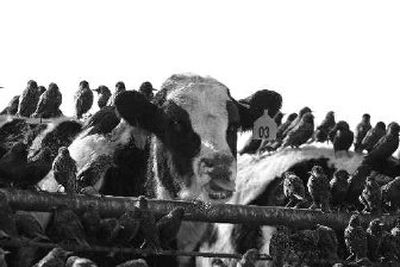Methane-driven ethanol plants are catching on

MEAD, Neb. — Ranchers have long been fond of saying cattle manure smells like money.
Now, folks in the business of making ethanol are smelling dollars too — in the methane gas emitted by manure at large cattle feedlots and dairies.
Across the country, ethanol plants powered by methane instead of costly natural gas or coal are on the drawing board — a movement that could be a win-win situation for the environment and the industry.
“We’ll produce ethanol much more efficiently and do it in an environmentally friendly way,” said Dennis Langley, CEO of Kansas-based E3 BioFuels.
Burning the methane will cut the amount of the greenhouse gas — which contributes to global warming — released into the environment.
And in addition to providing a cheap energy alternative, using methane addresses a longtime criticism that making ethanol uses too much natural gas or coal to produce.
Supporters of corn-based ethanol and other biofuels contend they burn cleaner than fossil fuels, reduce U.S. dependence on foreign oil and give farmers another market to sell their produce.
The first plant using a so-called methanol closed-loop system is set to begin operations here in February.
Under the closed-loop system at the Mead plant, manure will fall through metal slats in the cattle pens and be collected. Methane from the manure will be trapped instead of being allowed to drift into the atmosphere, and then used to generate power for the plant. Corn and grain will be used to produce ethanol and cattle will eat the wet distiller’s grain that is a byproduct of ethanol production, closing the loop.
Langley’s plant is next to a 28,000-head cattle feedlot. The cattle will produce roughly 244,000 tons of manure annually — more than enough to be the sole power source for the company’s 25-million-gallon ethanol plant.
If the plant and others like it are successful, they could begin increasing expectations about the environmental impact of alternative-fuel production.
“Cows are a major source of greenhouse gas,” said David Mager, vice president of Bion Environmental Technologies, a company helping livestock operations incorporate ethanol production by using manure. The company is working with about five ethanol plants now. “One-third of all methane comes from livestock.”
Langley’s company has a goal of completing 15 such plants over the next five years.
Other companies have similar plans to use methane to power ethanol plants.
Texas-based Panda Ethanol plans to build a total of four methane-powered ethanol plants in Texas, Colorado and Kansas, with the first scheduled to begin operations late this year.
And the boom is being fueled by more than a desire to help the environment.
A 40-million gallon ethanol plant can save millions of dollars annually in energy costs by using onsite methane instead of natural gas, Mager said.
“That’s a very big piece of this,” Mager said.
Traditional methods of making ethanol have been criticized for not reducing reliance on fossil fuels as much as advertised.
On average, it takes one unit of fossil-fuel based energy to produce ethanol containing between two and 2.5 units of energy, according to Langley.
A spokesman for the Renewable Fuels Association, a national trade association for ethanol, says the ratio is even lower, closer to one unit producing 1.67 units of ethanol energy.
Citing that ratio, “the idea that the energy balance equation goes against ethanol is really a non-argument anymore,” said Matt Hartwig of the trade association.
But Langley believes the margins are too thin and that traditional ethanol production is too inefficient to be sustainable.
One unit of energy at his plant, he says, will turn out more than 46 energy units from ethanol.
“We blow it away,” Langley said of his plant compared to traditional gas and coal-fired ethanol plants. “It’s a radical departure.”
But not one that will reform the entire ethanol industry, or even a large piece of it, said Hartwig. After all, one must have cattle — and lots of them — to make plants like the one near Mead work.
“You won’t be able to do it everywhere,” Hartwig said.
But manure isn’t the only source of methane.
Outside Jackson, Neb., Leonard Gill plans on drawing gas from trash. He has tons of it as owner of a regional landfill.
His L.P. Gill Landfill is now dotted with wells that will draw methane gas that, in some cases, has been trapped in the ground for decades.
Pipes will transport the methane to an ethanol plant about a mile away. The methane will provide a portion of the plant’s power and could save about $250,000 annually in energy costs, according to officials.